Legend has it that Bougatsa’s origin lies deep within the labyrinthine streets of Thessaloniki, where bakers guarded their cherished family recipes. Passed down from one generation to the next, this indulgent treat became a staple at Greek celebrations and gatherings, gracing tables with its captivating allure. My recipe uses store-bought phyllo dough sheets that get brushed and layered with butter, then filled with a super easy sweet custard, and baked to golden perfection.
While impressive in presentation, this Greek bougatsa recipe is simple to make at home with easy-to-find ingredients, a little bit of time, and following an easy set of instructions. For more Greek recipes, try my baklava recipe, koulourakia recipe, and recipe for spanakopita.
What You Need To Make This Recipe
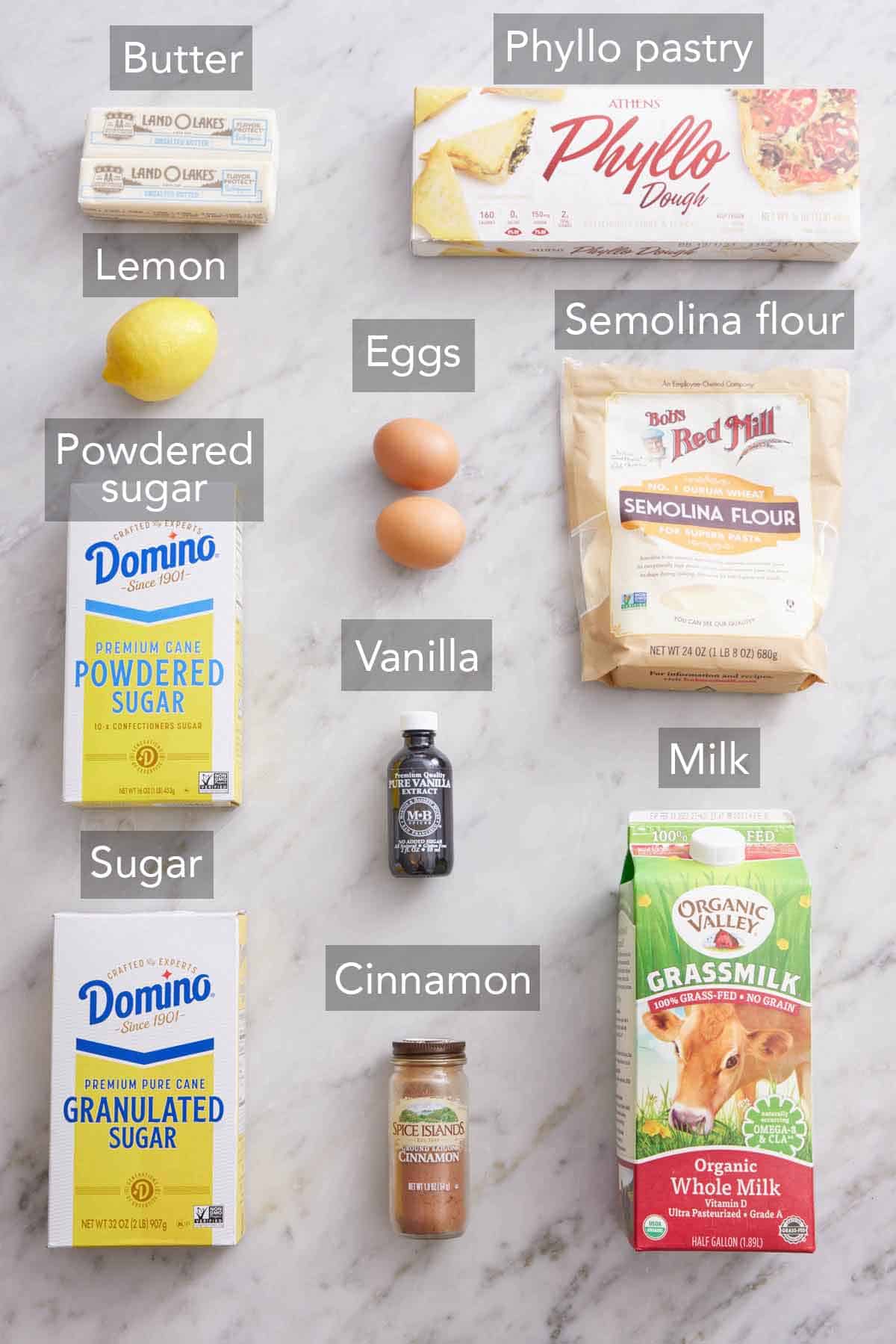
Eggs — while some recipes for this Greek custard pie call for egg yolks, I prefer the simplicity of whole egg custards. Let the eggs come to room temperature before starting to make them easier to whip. If you forgot to take them out of the fridge an hour before starting, you can always submerge them in a bowl of warm water for about 10 minutes.
Granulated Sugar — this neutral-flavored sweetener allows the sweet flavor of vanilla and lemon-laced semolina to shine. While you can use natural cane sugar, I do not recommend substituting granulated sugar for brown sugar.
Whole Milk — using full-fat milk will ensure your Greek dessert custard has the perfect dreamy mouthfeel you’d expect from bougatsa..
Semolina Flour — semolina flour is a wheat flour but has a coarser texture than regular all-purpose flour. While it’s probably best known for making pasta, when used in baking, semolina flour imparts a unique nutty flavor to anything it touches. In this Bougatsa recipe, the semolina acts as a thickening agent as well as contributes to the classic grainy texture of the custard.
Unsalted Butter — unsalted butter is best in this Greek custard dessert, but in a pinch, you can swap in salted. Just note that the flavor will be slightly different since most bougatsa recipes don’t include any salt.
Lemon Zest — fresh lemon zest adds brightness to the semolina pudding center. Make sure you’re only using the bright yellow part of the zest, as the white pith is very bitter. A microplane works best.
Phyllo Pastry — phyllo is a paper-thin pastry dough. You can find packages of the dough sheets in the freezer section with frozen pie shells or puff pastry. Boxes are sometimes labeled “filo sheets” or “fillo dough.” Do not substitute the phyllo for any other type of pastry dough in this bougatsa recipe.
How To Make Bougatsa
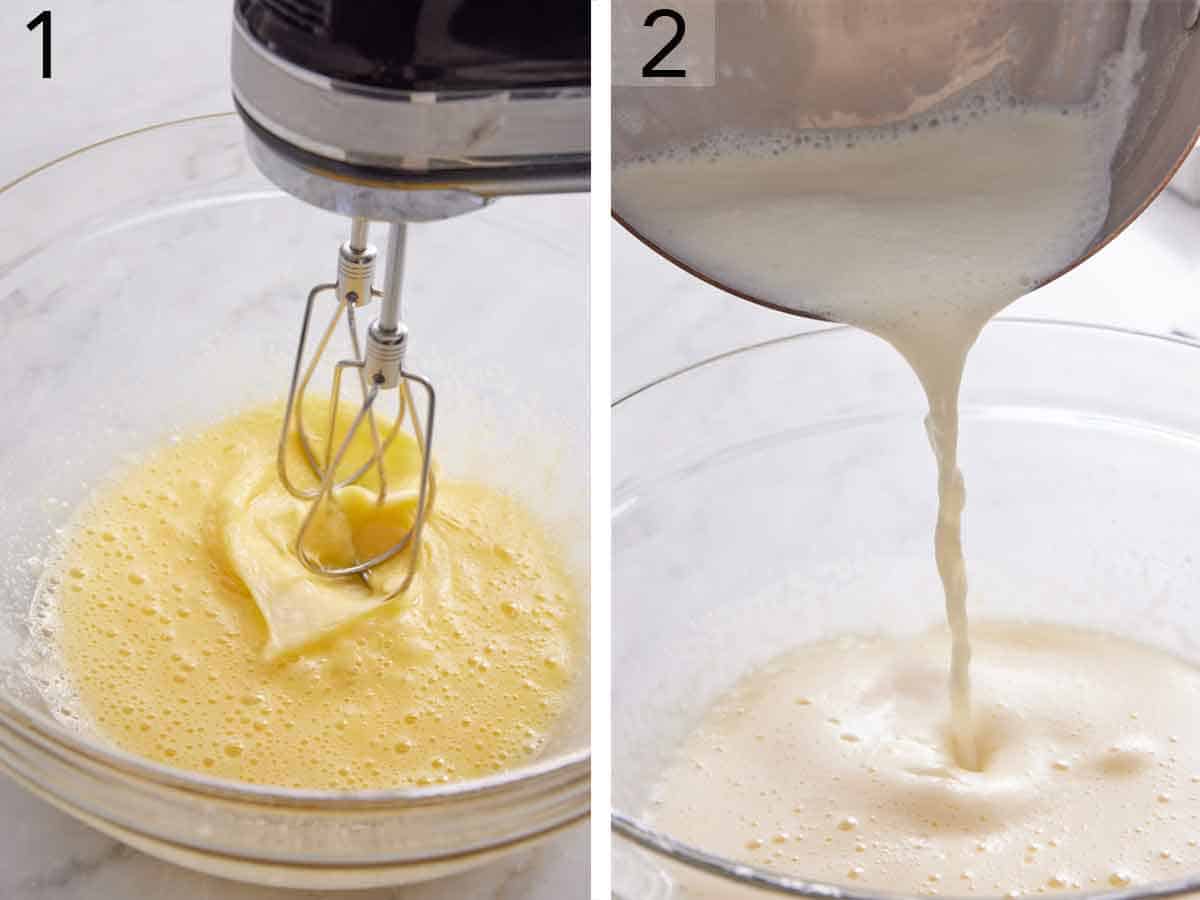
1. In a large bowl, beat the eggs with an electric mixer on medium speed until frothy, about 30 seconds. Gradually beat in the granulated sugar until thick and foamy, about 4 minutes. Set aside.
2. In a medium saucepan, heat the milk over medium heat, stirring constantly, until just beginning to simmer. With the mixer on low, slowly pour the hot milk into the egg mixture until fully combined. Return the milk mixture to the saucepan. Set over medium-low heat, and stir constantly until just beginning to simmer, about 3 to 4 minutes. Gradually whisk in the semolina. Reduce the heat to low, and stir constantly until thickened, about 1 minute.
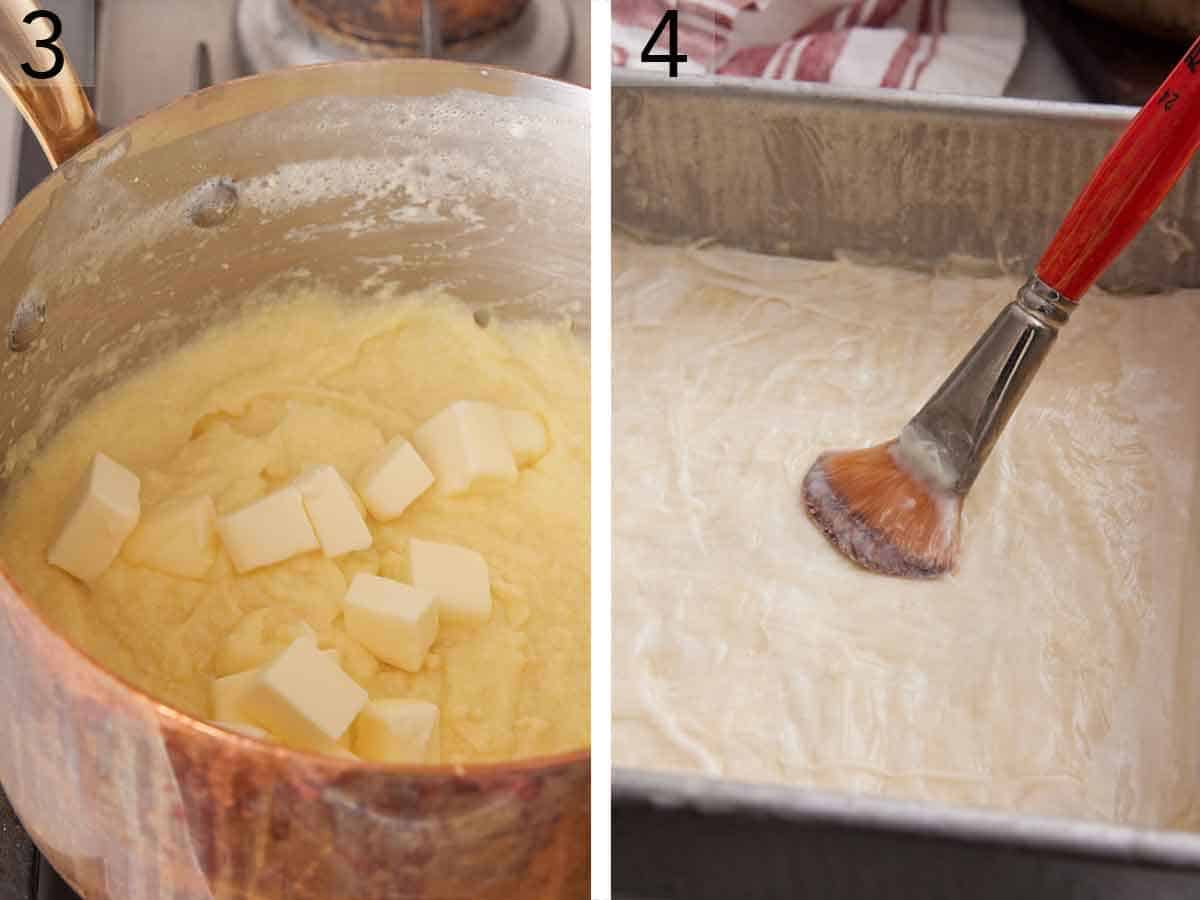
3. Whisk in the cubed butter until fully melted and combined. Remove from the heat. Whisk in the lemon zest and vanilla extract. Let stand at room temperature, stirring occasionally while preparing the pastry layer. While the custard is cooling, preheat the oven to 350°F. Lightly grease an 8×8-inch baking dish with baking spray or butter. Unroll the phyllo pastry sheets, and keep them loosely covered with a damp towel.
4. Place 1 sheet of phyllo in the prepared baking pan, scrunching down the excess to fit into the sides of pan. Using a pastry brush, generously brush with melted butter. Place another sheet of pastry on top perpendicular to the first sheet. Scrunch down the sides and brush with butter. Repeat the process, placing 4 more sheets of pastry alternating between vertically and horizontally, creating a bottom layer total of 6 sheets.
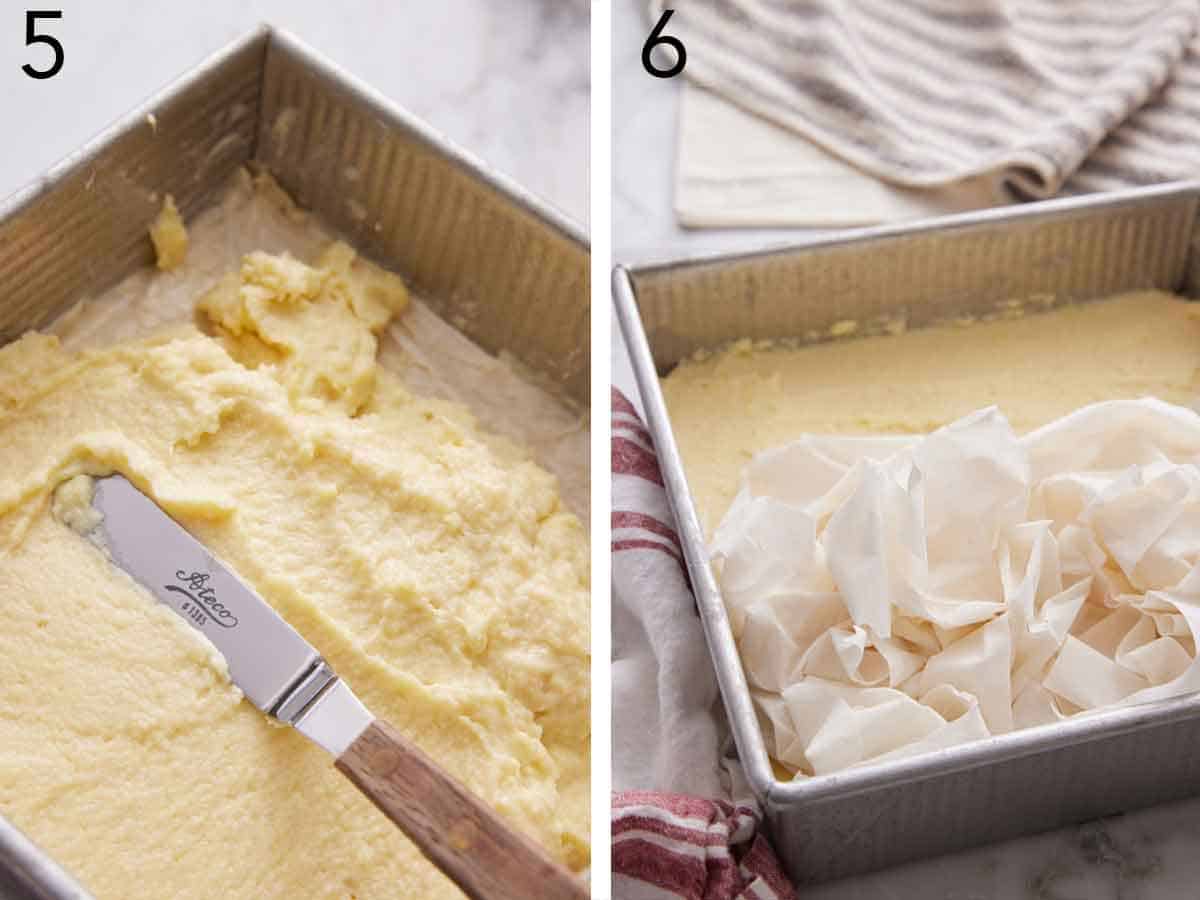
5. Spoon the cooled custard into the pastry and spread in an even layer.
6. Scrunch the remaining 6 sheets of phyllo into ruffly mounds and place in an even layer on top of the custard.
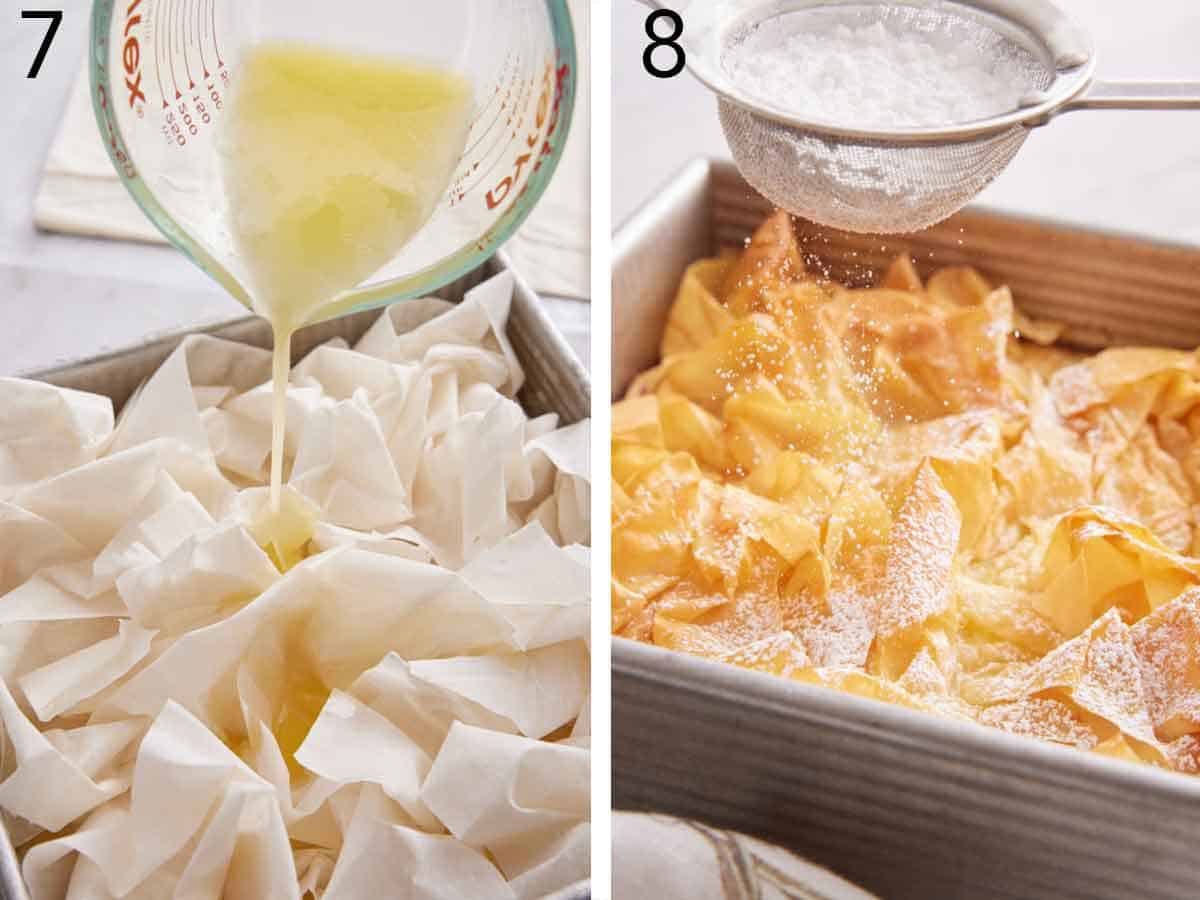
7. Drizzle with the remaining melted butter (about 1/4 cup) until fully coated. Bake for 45 minutes or until the pastry is golden brown and crispy. Let cool for 30 minutes.
8. Dust with confectioners’ sugar and ground cinnamon before serving. While it’s best served shortly after being baked, any leftover Bougatsa can be loosely covered and refrigerated for up to 3 days.
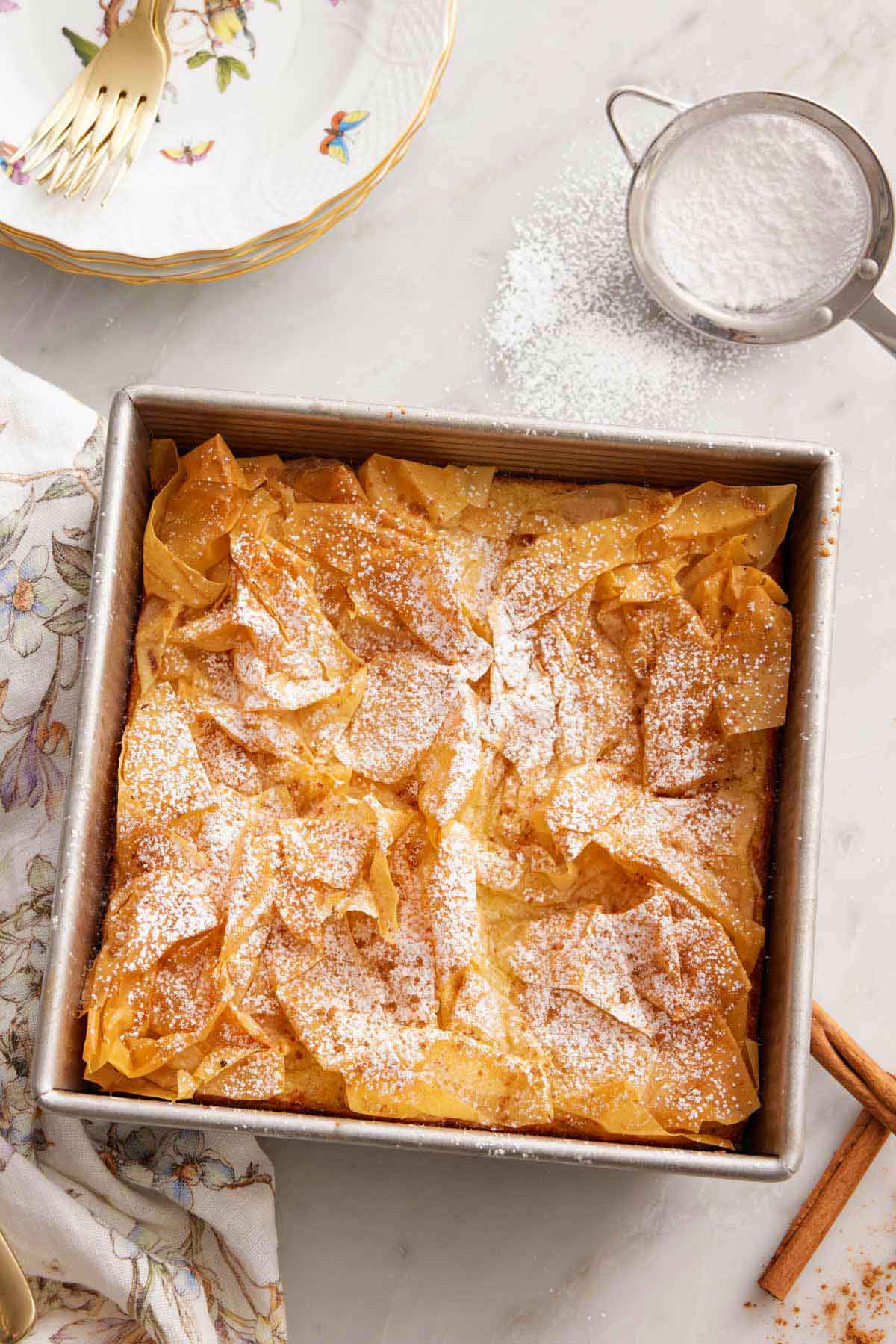
Pro Tips For Making This Recipe
- Take care of your phyllo. Keep the phyllo sheets covered with a damp cloth while working to prevent it from drying out and becoming brittle. Work quickly but gently when layering the sheets, brushing each layer with melted butter. You want to alternate which direction you are placing the phyllo layers so that all sides of pan are covered.
- Be patient when cooking the custard. The creamy custard filling is the heart of Bougatsa, and getting the consistency right is crucial. Slowly cooking the semolina over low to medium heat and stirring constantly helps to avoid any lumps.
- Be sure to fold in the edges to seal. When assembling the Bougatsa, gently fold the excess phyllo inward over the custard to seal it inside to prevent leakage during baking and maintain the beautiful shape of the pastry.
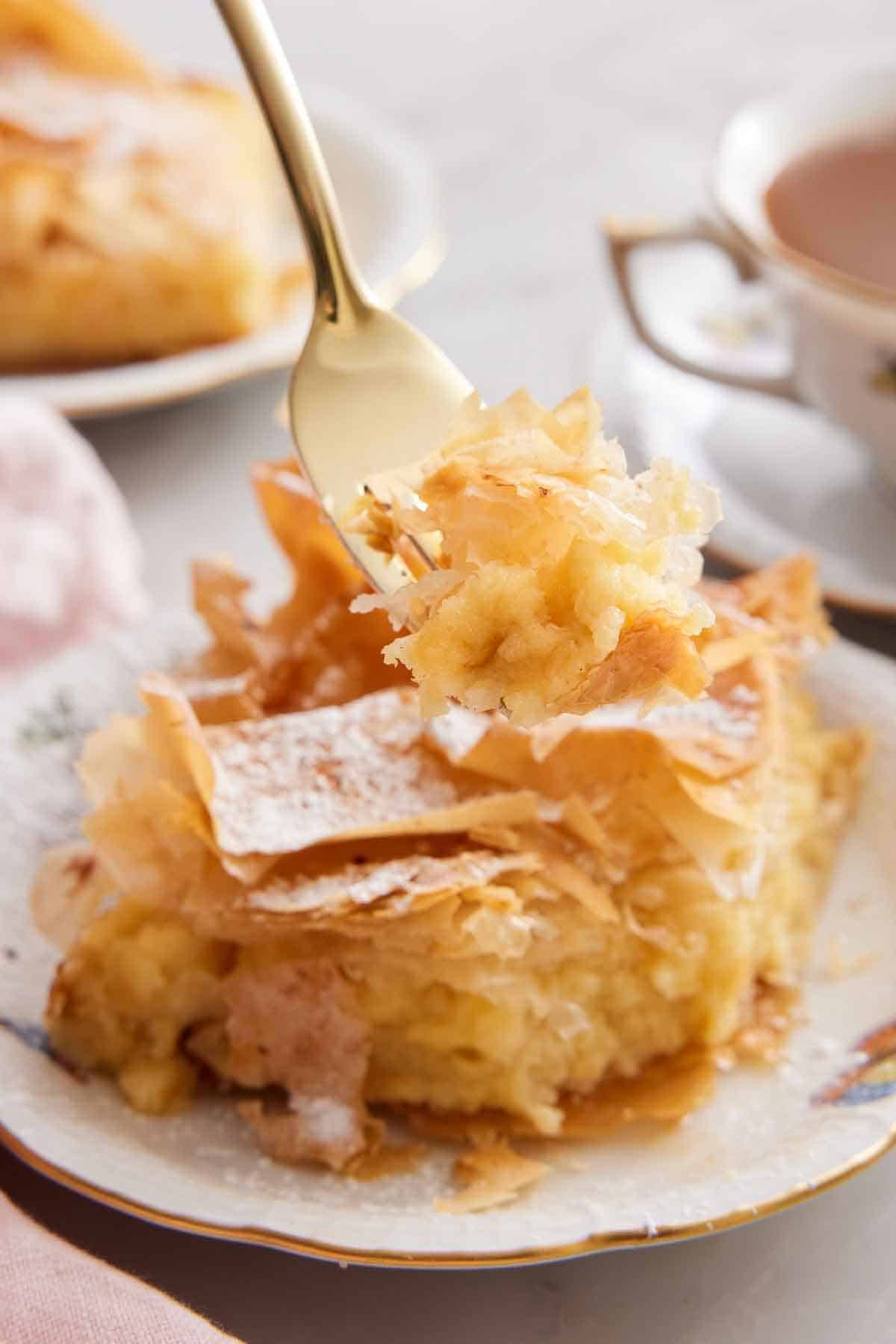
Frequently Asked Questions
You can rewrap the phyllo in plastic wrap and freeze for later use. If you have any little pieces of phyllo dough that flaked off or broke in the process of assembly, add them on top of the custard as part of your scrunched-up topping.
Taste is subjective, so that’ll depend on your palate. I’d have to say it’s a tie between this bougatsa recipe and baklava!
There’s no literal translation that I know of, but it is defined as a sweet or savory pastry filled with semolina custard.
If you’ve tried this Bougatsa recipe, then don’t forget to rate the recipe and let me know how you got on in the comments below, I love hearing from you!
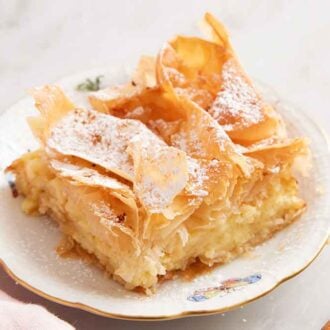
Bougatsa
Equipment
- Electric mixer
- Saucepan
- 8×8″ cake pan
Ingredients
- 2 large eggs
- ¼ cup granulated sugar (50g)
- 1½ cups whole milk (360mL)
- ¼ cup semolina flour (46g)
- ½ cup unsalted butter cubed (113g)
- 2 teaspoons lemon zest
- 1 teaspoon vanilla extract
- 12 sheets phyllo pastry thawed
- ½ cup unsalted butter melted (113g)
- 1 tablespoon confectioners’ sugar
- ¼ teaspoon ground cinnamon
Instructions
- In a large bowl, beat the eggs with an electric mixer on medium speed until frothy, about 30 seconds. Gradually beat in the granulated sugar until thick and foamy, about 4 minutes. Set aside.
- In a medium saucepan, heat the milk over medium heat, stirring constantly, until just beginning to simmer. With the mixer on low, slowly pour the hot milk into the egg mixture until fully combined. Return the egg mixture to the saucepan. Set over medium-low heat, and stir constantly until just beginning to simmer, about 3 to 4 minutes.
- Gradually whisk in the semolina. Reduce the heat to low, and stir constantly until thickened, about 1 minute. Whisk in the cubed butter until fully melted and combined. Remove from the heat.
- Whisk in the lemon zest and vanilla. Let stand at room temperature, stirring occasionally while preparing the pastry layer.
- While the custard is cooling, preheat the oven to 350°F. Lightly grease an 8×8-inch baking pan with baking spray or butter.
- Unroll the phyllo pastry sheets, and keep them loosely covered with a damp towel. Place 1 sheet of phyllo in the prepared baking pan, scrunching down the excess phyllo to fit into the sides of pan. Generously brush with melted butter. Place another sheet on top perpendicular to the first sheet. Scrunch down the sides and brush with butter. Repeat the process, alternating between placing sheets vertically and horizontally, with 4 more sheets of pastry, creating a bottom layer total of 6 sheets.
- Spoon the cooled custard into the pastry and spread in an even layer. Scrunch the remaining 6 sheets of phyllo into ruffly mounds and place in an even layer on top of the custard. Drizzle with the remaining melted butter (about 1/4 cup) until fully coated.
- Bake for 45 minutes or until the pastry is golden brown and crispy. Let cool for 30 minutes at room temperature. Dust with confectioners’ sugar and cinnamon before serving. While it’s best served shortly after being baked, any leftover Bougatsa can be loosely covered and refrigerated for up to 3 days.
Notes
- Take care of your phyllo. Keep the phyllo sheets covered with a damp cloth while working to prevent it from drying out and becoming brittle. Work quickly but gently when layering the sheets, brushing each layer with melted butter. You want to alternate which direction you are placing the phyllo layers so that all sides of pan are covered.
- Be patient when cooking the custard. The creamy custard filling is the heart of Bougatsa, and getting the consistency right is crucial. Slowly cooking the semolina over low to medium heat and stirring constantly helps to avoid any lumps.
- Be sure to fold in the edges to seal. When assembling the Bougatsa, gently fold the excess phyllo inward over the custard to seal it inside to prevent leakage during baking and maintain the beautiful shape of the pastry.



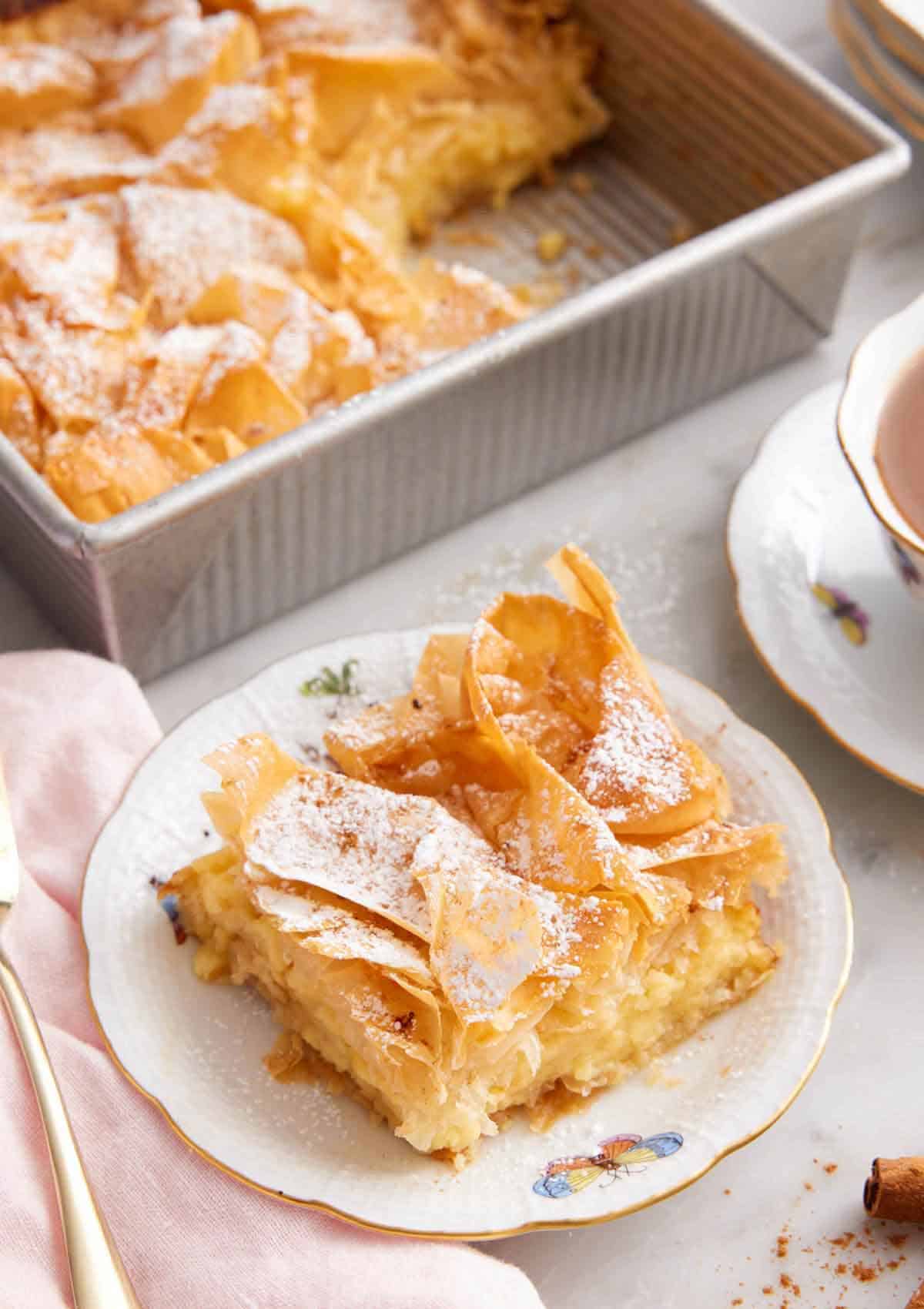
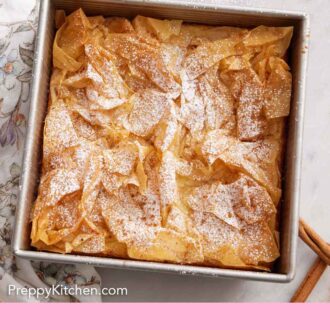
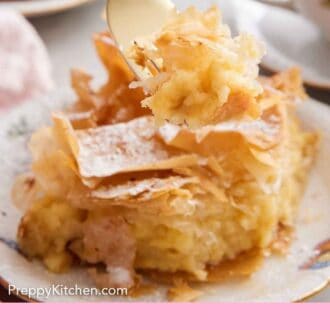
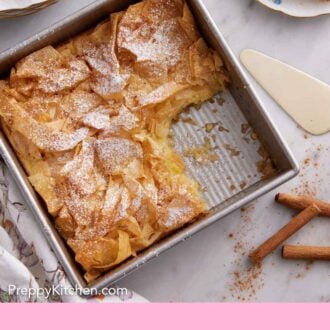
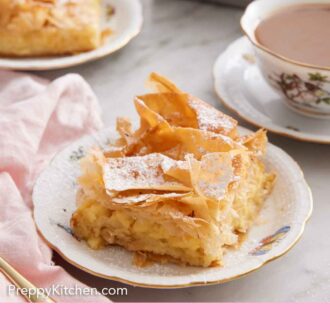
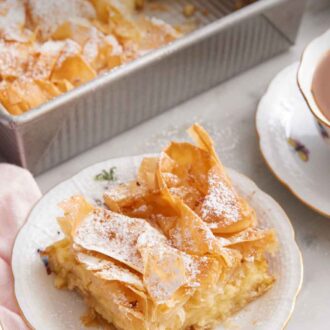
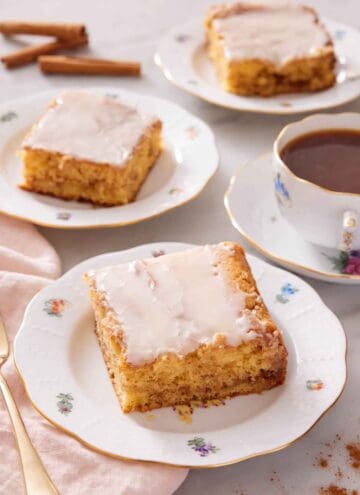
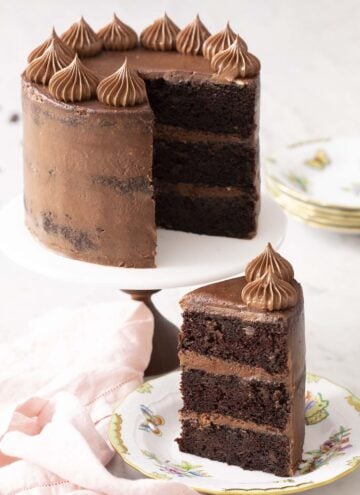
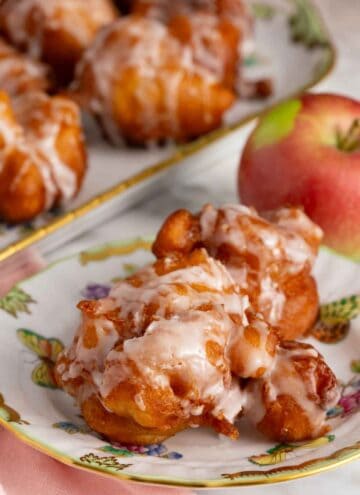
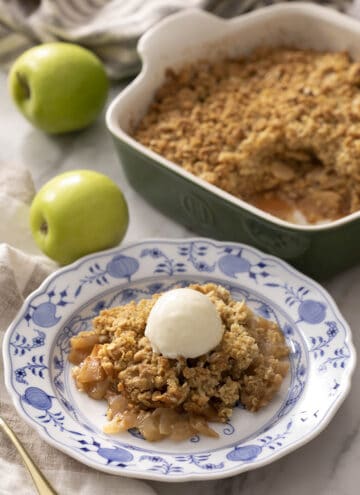
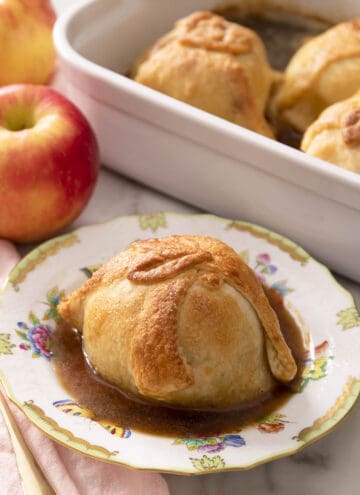
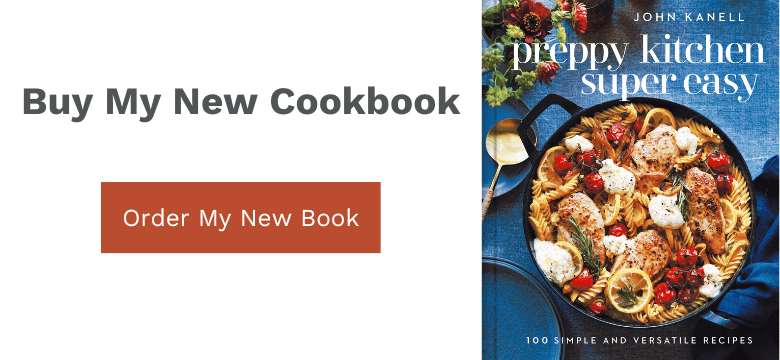
Leave a Reply